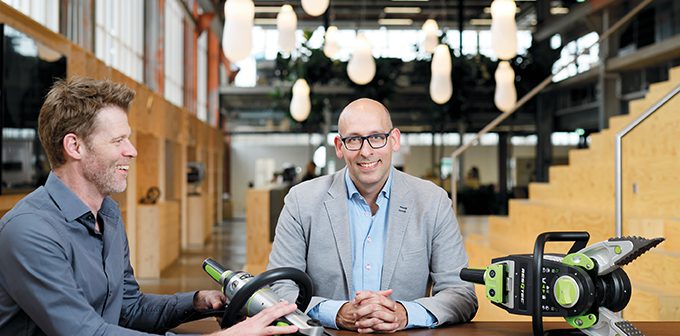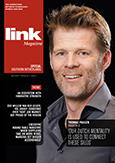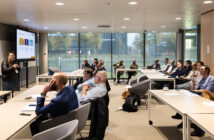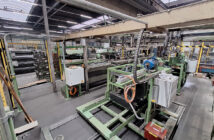The likelihood of success in the market is greatest when you consider a product from as many perspectives as possible in the design phase. This is exactly where the success of the Eindhoven-based design agency VanBerlo lies. Enjoying success abroad as well, using the (southern) Dutch polder mentality to engage stakeholders in dialogue with each other. And, as it happens, about a collection of polystyrene forms. A conversation with CEO Thomas Paulen and one of VanBerlo’s innovation strategists, Ivo Lamers.
THEME: AN ECOSYSTEM WITH INNOVATIVE STRENGTH
‘When I visit a company for the first time, I always take in my surroundings. When I engage in conversation with the customer’s team, I look at its composition. Who is in the team, what competencies, interests they have. Which one of my employees, with what traits, should I bring in with me and which team member should I pair them with? And what if that technological solution does not transpire, or if that market participant pulls out? Trying to quickly take in a new playing field, i.e. who the actors are, what interests they have and running through the different scenarios in my mind is second nature to me. I am always thinking about tomorrow and what I am going to do.’
(Southern) Dutch polder mentality brings design agency VanBerlo worldwide success
Capacity for empathy
This single-minded focus on his surroundings, this capacity for empathy is essential to Thomas Paulen. And to his nearly 100 employees. Because VanBerlo is by no means a design agency looking to just ‘design something nice’. What he and his people add to the high-tech industry is, in fact, a broad view. Not only of that technological development for that new product – the traditional comfort zone of the average techie – but also of the supply chain, the parties involved in the development and production of that product and – of course – of the customer, the end-user and the business side. ‘The people here,’ he continues, ‘are all very different; it is the one character trait they all have in common. They involve others in their work and feel involved in the work of others. If at the end of the day someone is struggling with a deadline, he is not left to his fate.’
Bias rears its head
In that 360-degree perspective lies a large part of the success of VanBerlo, which has built a reputation that extends far beyond Europe. Because that perspective is often lacking within the customer’s company. ‘B2B often involves technologically complex matters. All your energy is invested there. That is why we always ask: ‘Why would this be a success in the market?’ By their very nature, larger companies usually consist of silos erected around the ivory towers they occasionally inhabit, adds his colleague and senior innovation strategist, Ivo Lamers. And that is when bias rears its head. ‘There may be times when a technological innovation is based on a customer complaint that has made its way through six echelons to the CEO, for example, but if you ask other customers about it, they don’t recognise it. So, we always look into what the actual relevance is for the end-user, for that operator in China.’ Paulen jumps up and pulls two pairs of hydraulic shears – firefighting tools for cutting open crashed cars, among other things – out of a cabinet. ‘When we were doing market research on this, we talked to firefighters. Not about the technical specifications. Or about how much pressure you can place on the jaws; neither of those things seemed to be important to them. They were more interested in knowing whether they could hang it over their shoulder so they could have their hands free. Or whether they could use it with one hand. That is why this tool has become a success on the market’, he says, pointing to the small pair of shears, which also happen to be a lot lighter.
In the B2B and the B2C
‘VHS and later Blue Ray’, Lamers continues, ‘drove Betamax/Video2000 and HD DVD out of the market, thanks to manufacturer’s solid understanding of its surroundings. Understood that you had to work with film and game producers to keep a sufficient amount of content readily available to consumers.’ And revamped its earning model (e.g. selling PlayStations below cost price in order to create an install base for Blu Ray). It seems so obvious, but Paulen and Lamers don’t see anything strange about the industry’s lack of attention to all those different perspectives, to that of the competitors, the operators, the service people, and so on. And they see this complacency in both the B2B and B2C markets. Because whether it is ASML’s EUV machine or Reckitt Benckiser’s plastic Lysol bottle, the interests of all stakeholders form a complex whole. ‘That bottle looks like a simple product. But before we started working on it as designers, we had to comply with numerous conditions, such as learning the exact way in which the existing fillers work in order to ensure that the new bottles can pass over it without causing malfunctions. Or that the screw cap must be tightened on the bottle with forceful torque….’
Polystyrene
To analyse the product from all these different perspectives at as early a stage as possible, Paulen et al. involve as many of the internal and external stakeholders as possible. ‘Of course, we have the advantage of visualisation on our side. Sometimes using a sketch, a digital image or a virtual reality solution, and other times coming up with a collection of polystyrene forms, each representing a particular module. Everyone laughs about it at first, but within three minutes they’re all there – the electrical, mechanical and mechatronic engineers of the customer, suppliers, service people… – working hard together. ‘Can this module be installed here, or will it affect the heat regulation?’ ‘If you place that module there, it will be difficult for the service people to reach.’
‘That suppliers have to be brought on board early on is something they understand well at ASML, for example, where they pull in suppliers at an early stage. Sometimes literally’, says Thomas Paulen.
Poldering
It is therefore an added bonus if the participants have mastered the art of ‘poldering’. That quality, Paulen and Lamers note – while thinking about their portfolio of international customers – is well-developed in the Netherlands, certainly in the direct vicinity of their southern Dutch base. ‘In this region, it’s usually about the arguments, not about who raises them. We have an open culture of direct communication where hierarchy plays a relatively minor role. Companies in Asia engage us because we aren’t afraid to challenge the customer. It does not always go well, however’, says Paulen. ‘I remember a project where we disagreed with the R&D manager, and we took the disagreement to the CEO, who agreed with us. The product became a success, but we never heard back from that company ever again. Probably because that R&D manager doesn’t want to have anything to do with us…’
Connecting silos
But those are exceptions. Van-Berlo’s approach is generally effective, however. The Eindhoven-based company rakes in a lot of revenue in countries such as Germany and Great Britain. ‘You have to accept that you usually have to start small,’ says Paulen. ‘At first, you can only ‘make nice things’. But step by step, our Dutch mentality is used to connect these silos in order to ensure that the additional costs R&D incurs for marketing also become marketing’s problem. It is no coincidence that we are the only non-British design firm for a company like Reckitt Benckiser.’ ‘In all these years’, continues Lamers, ‘we have obviously looked into many a different kitchen, which has allowed us to quickly understand what is going on, who should be involved. Which suppliers should be engaged.’
Strong CEO
Poldering is not only a typically Dutch quality, small young companies are generally much better at it than large corporations. This is due to the lack of standing bureaucratic patterns at those start-ups and the greater dependence on suppliers. But sometimes it also has a lot to do with the entrepreneur himself, which is what Paulen firmly believes. ‘We helped design Additive Industries’ metal printer, but played a rather small role in the entire project. It was the entrepreneurs Daan Kersten and Jonas Wintermans, who, with their vision for the market and knowledge of the market and supply base, played a binding role in bringing all parties on board, not as jobbers, but as fully-fledged participants. If a company in the US is successful with its innovations, it has nothing to do with its poldering ability, but with a strong CEO that is the binding factor. Musk plays that role at Tesla and Jobs played it at Apple.’
Hitting the coffee machine
In his own way, Thomas Paulen tries to play that binding role not only for the customer, but also as manager within Van Berlo. ‘I approach the management of this company as a design project. I want to know where the areas of tension within the company are, balance the interests. When I see someone coming in in the morning and I have a feeling that something is troubling them, I make sure that we hit the coffee machine at the same time.’
www.vanberlo.nl
Like-minded people, groundbreaking innovations
The small job market is on everyone’s lips in the southern Dutch high-tech industry. But not at VanBerlo. ‘Of course, trying to find, say, a specialised software engineer is not going to be a walk in the park for us either. But we can usually find the people we need without a problem. We have maintained close contact with the universities and universities of applied sciences for many years and there are always some ten interns and graduates – we have selected – walking around here somewhere. And we have built a good name for ourselves in the market, which was underscored last November when the Erasmus University named us the most innovative company in the Netherlands. Designers are keen to work here.’
Still, the small job market concerns Thomas Paulen and Ivo Lamers for another reason. ‘The majority of the new houses on Strijp R in Eindhoven have been sold to expats. The enormous amount of talent needed here comes increasingly from outside the Netherlands. At the same time, more and more companies – FEI, Assembléon, NXP – are falling into foreign hands. This region has grown big because of Philips, where like-minded people have created truly groundbreaking innovations. Innovations on which this region is still expanding. The strength at that time lay in that integrated cooperation. The strength of this region still lies in that ecosystem of like-minded people who work together and know and understand each other through and through. Together, we must ensure that it stays that way.’
‘Precisely that mix of design and technology is able to bring the future closer’
‘It can be pretty tough to bring the worlds of high-tech and industrial design together. Technological SMEs in particular often fail to recognise the power that designers can add to their technology by putting the user first’, says Martijn Paulen, director of the Dutch Design Foundation and organiser of the Dutch Design Week (DDW). The purpose of the event is to draw as many sophisticated visitors – clients, development partners and journalists – to Eindhoven and to introduce them to the industrial designers and their work. Given the growth in visitor numbers from 200,000 in 2012 to 335,000 in 2017, 20 percent of which goal-oriented professionals from abroad, the event appears to become increasingly successful in achieving this purpose.

This year’s edition of the Dutch Design Week is held 20-28 October. Foto DDW
Only design and technology are able to achieve that human-centred innovation market is asking for. And the DDW is bridging the gap between those two worlds’, says Paulen. ‘I see quite a few SME owners who consider the week an ‘enjoyable outing’, only to discover upon arrival that there are designers showing off their designs, which means potential business for them. Our chief sponsor ABN Amro also made that switch. The bank started its sponsorship from the same cultural angle they chose to back theatre financially. These days, however, the bank is inviting many B2B customers from sectors such as high-tech, food and health care.
It is no coincidence that the DDW, in its capacity as intermediary between design and technology, originated precisely in a region where both high-tech R&D and industrial design have a strong presence, Paulen believes. Neither is it a coincidence that the event has a signature of its own that puts ‘design for the future’ at centre stage. ‘The DDW is not an event such as that in Milan, where – primarily – designs are presented that are finished and for sale. One of the objects is to show prototypes that may take another three years in order for them to become marketable. We also like to show the choices made to arrive at those prototypes, including all the experiments that failed. Precisely because you can learn a lot from that as a visitor. The DDW does in fact show the R&D of industrial design. Thanks to the Philips roots, this is a high-tech fiddling and tinkering region. At the same time, it is a region that boasts considerable creative strength. Precisely that mix is well able to bring the future closer’, says Martijn Paulen, who has a brother called Thomas. The fact that both have ended up in the world of industrial design is no coincidence either: ‘Thomas is older and went for Industrial Design at Delft University of Technology, which I found mighty interesting. Although I didn’t finish that course myself, I eventually ended up in this world as well.’
This year’s edition of the Dutch Design Week is held 20-28 October.






